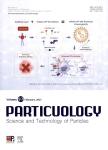Preparation of thalidomide nano-flakes by supercritical antisolvent with enhanced mass transfer
Preparation of thalidomide nano-flakes by supercritical antisolvent with enhanced mass transfer作者机构:School of Chemistry and Chemical Engineering ShanghaiJiaotong University Shanghai China Department of Chemical Engineering Auburn University Auburn AL USA
出 版 物:《Particuology》 (颗粒学报(英文版))
年 卷 期:2012年第10卷第1期
页 面:17-23页
核心收录:
学科分类:1007[医学-药学(可授医学、理学学位)] 100704[医学-药物分析学] 081703[工学-生物化工] 08[工学] 0817[工学-化学工程与技术] 0836[工学-生物工程] 082203[工学-发酵工程] 0822[工学-轻工技术与工程] 10[医学]
基 金:supported by the National 863 Programme Foundation from the Ministry of Science and Technology of the People's Republic of China(2007AA10Z350) the National Natural Science Foundation of China(20976103)
主 题:Supercritical Anti-solventUltrasound Thalidomide Nano-flakes Polymorph
摘 要:Thalidomide treats multiple myeloma and protracts life-span of patient, but its bioavailability is limited as it is poorly water soluble. Thalidomide nano-flakes are produced to improve the drug dissolution rate. Two nanoflake production methods are utilized for a comparative study: a supercritical antisolvent (SAS) method and a supercritical antisolvent with enhanced mass transfer (SAS-EM). SAS-EM utilizes ultrasonication to improve dispersion upon injection within the supercritical carbon dioxide. Comparative study of SAS and SAS-EM thalidomide confirmed that the application of ultrasonication improved the micro/nano particles produced by SAS. The effects of ultrasound power on the formation of thalidomide particles are examined. The particle size and morphology were characterized by SEM. The thalidomide nano-flakes produced by SAS-EM were smaller than the particles produced by SAS. Dissolution rates of the produced particles, evaluated by HPLC, demonstrated an increase in the thalidomide dissolution rate for the SAS-EM produced particles, The polymorphs and crystallinity of thalidomide particles (flakes) were observed by FTIR and XRD. In this research, the supercritical processing significantly modified the crystal formation of thalidomide from an original state of a β-polymorph to the amorphous state α-polymorph after suoercritical orocessing.




